Axolotls are fascinating aquatic creatures that make great pets. These friendly and interactive salamanders are easy to care for.
However, the overall well-being of your little dragon largely depends on the way you set up the aquarium.
Putting some live plants in the tank is one of the best things you can do for your axolotl.
Live plants not only look beautiful but also offer some other benefits. If you are wondering what plants are good for an axolotl tank, keep reading.
We are going to discuss 5 cold water plants for axolotl. After reading this post, hopefully you will be able to make an informed decision.
Contents
Benefits of Cold Water Plants for Axolotl
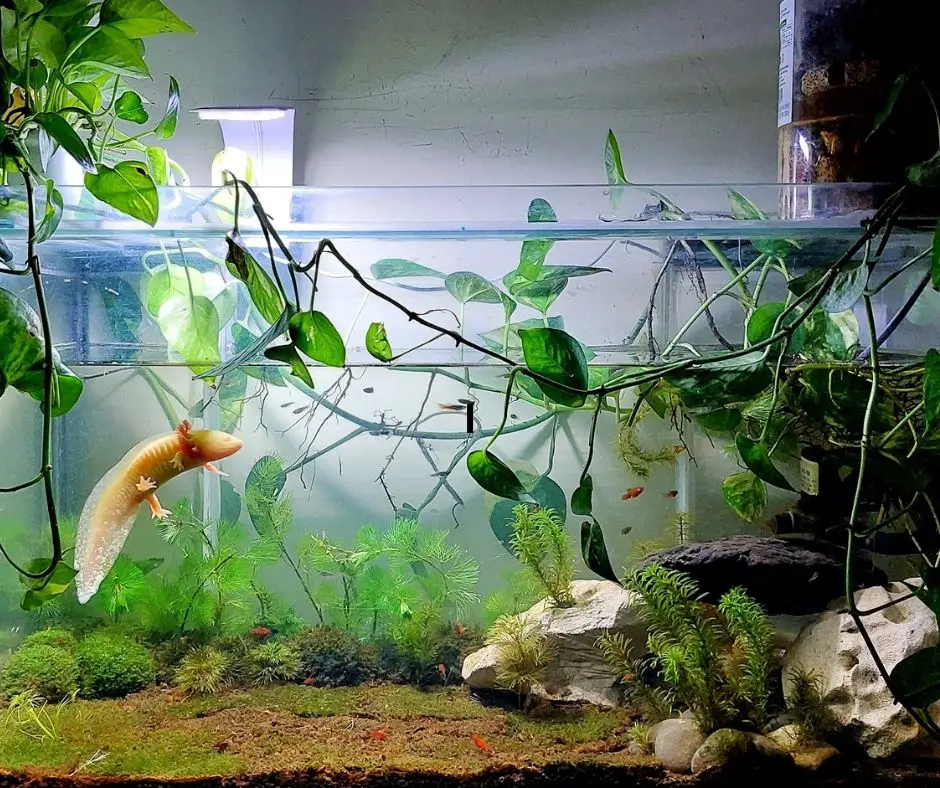
Cold water plants are plants that can be maintained at room temperature.
While most aquatic plants require a minimum water temperature of around 20°C, cold water plants do pretty well in lower temperatures.
When choosing plants for an axolotl tank, it is important to look for cold water plants because axolotls are cold water creatures.
The ideal water temperature for an axolotl is about 16-18°C, so it makes sense that cold water plants are suitable for an axolotl habitat.
The benefits include water oxygenation, nitrate reduction, and aesthetic appeal. These plants look nice and natural in aquariums. Above all, axolotls just love these plants.
Also read: Full Requirements & Water Conditions for Axolotl in Captivity
6 Best Cold Water Plants for Axolotl
Java, Anubias, Java fern, hornwort, duckweed, and marimo are the top 6 cold water plants for axolotl tanks. These plants thrive in low temperatures—just like axolotls.
The plants are not planted into the substrate, and therefore axolotls can’t dig them up. Rest assured that your axolotl will love any of these six options.
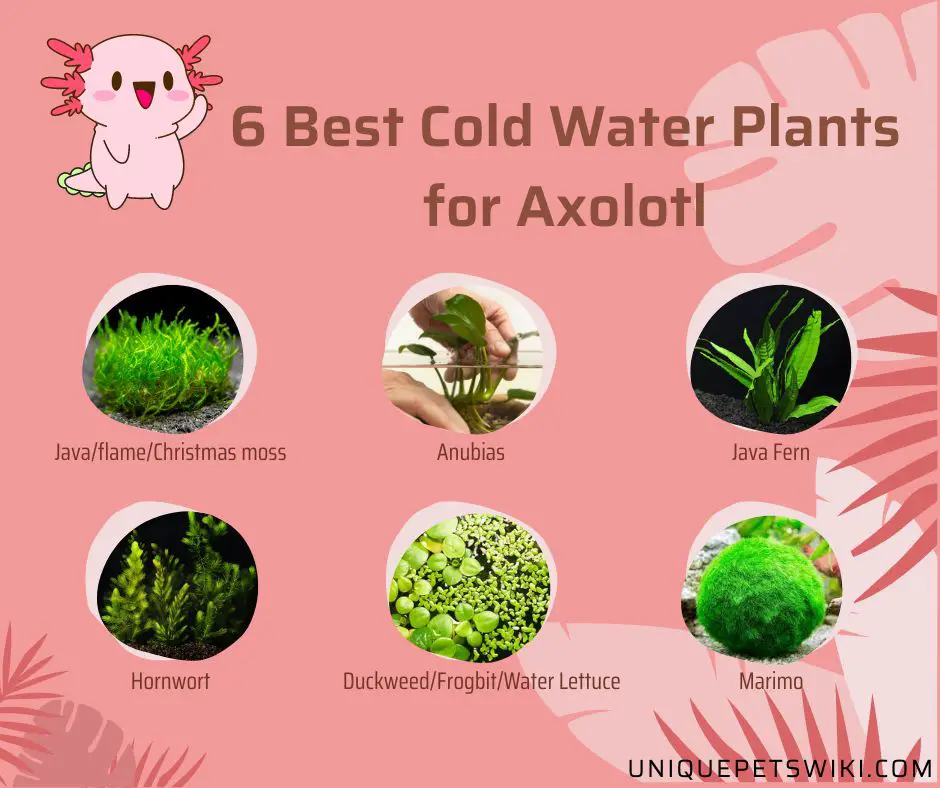
1. Java/flame/Christmas moss
Christmas moss has moderate lighting requirements. It looks amazing in a tank, and thrives in pretty cold water. It grows into a mat-like shape on which axolotls love to lay.
And if you allow it to grow for months and years, it may take the shape of a carpet!
Growing Christmas moss is easy. A great thing about this plant is that it does not require additional fertilizer or co2. If you keep shrimp in the same tank, Christmas moss can serve as a great hiding spot.
With that said, this plant has a disadvantage: it grows slow. It may not look vibrant if it gets very little light. The plan releases green hair algae that can cloud the water.
Java moss is suitable for not only axolotl tanks but also all aquariums. They provide aesthetic beauty and serve as a shelter for axolotls. Java moss is also very easy to grow and maintain.
2. Anubias
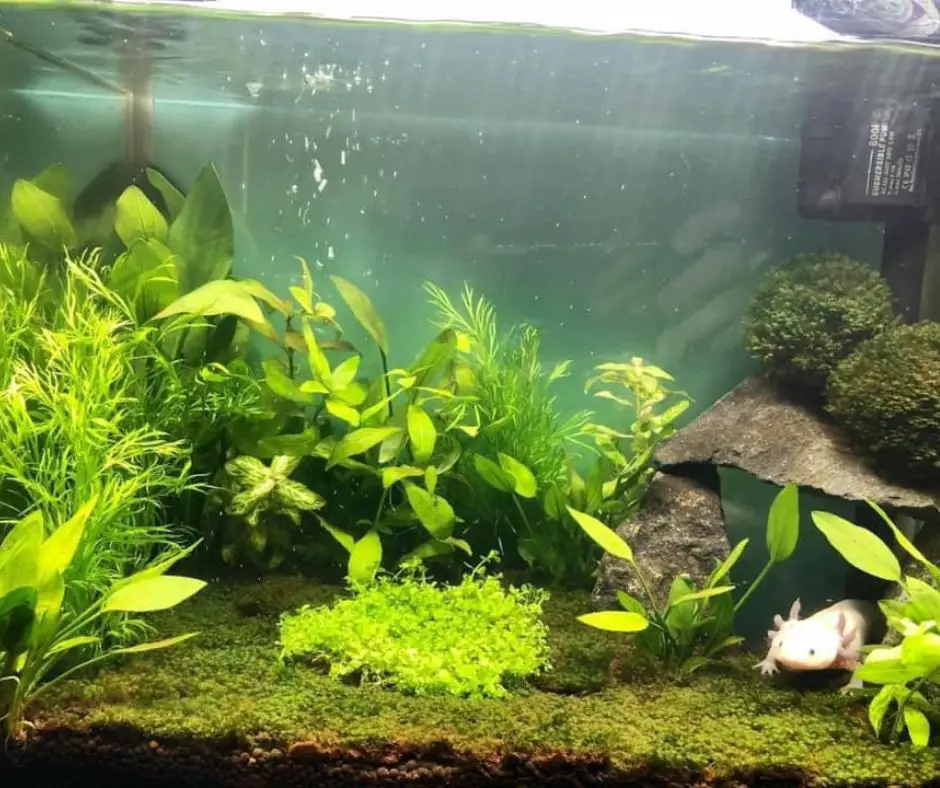
Anubias is among the best plants for axolotl tanks. They are very hard and resistant, and therefore do not easily get destroyed.
The plants are great not just for axolotl tanks, in fact, they are used for a variety of aquarium set ups.
Anubias come in several species and subspecies. So, there are multiple shapes, leaf sizes, and shades of green to choose from.
The most common of them is called anubias nana. It’s very hardy, and requires very little attention.
Anubia Isabelle is taller than nana, but pretty tough. The last type, Anubia Barteri, has larger and rounder leaves.
Anubias are aquatic, so it is a good idea to tie these plants to something static in the tank. Your axolotl will love this plant.
Anubias tend to collect brown algae. So, when you change water, consider wiping the leaves. Another good solution is to keep shrimp in the same tank. This plant thrives with light fertilizers.
But using fertilizers in the water may be risky for your axolotl. If you want to use fertilizers, be careful about the dosage.
Greenpro Anubias Barteri VAR Barteri Leaf Potted Freshwater Live Aquarium Plants
- AQUARIUM PLANTS PACKAGE : Bolbitis Asiatica Heteroclita from Greenpro come with strong growing system to ensure those roots will tank nutrients from your substrate as a root feeder.
- COLOR YOUR TANK : Basic starter for you tank, creating well background cover. Great for any aquatic pets.
- BEST QUALITY | With our experience, every plants from Greenpro will be professionally inspected, packed and organized with suitable boxes for all weather conditions to make sure that will retain the freshness and healthiness to our customer hands.
- PROVIDES AMAZING ENVIRONMENT : Aquatic plants will produce oxygen and absorb carbon dioxide to enhance water quality in your aquarium community. Adding live plants not only beneficial for the natural ecosystem but also giving shelter and security place for your aquarium pets.
- 100% GUARANTEE : Our plants grown by using the latest technology and facility with digital controlled nursery to ensure that our plants are 100% diseases pest snail and algae free.
Last update on 2022-12-29 / Affiliate links / Images from Amazon Product Advertising API
3. Java Fern
Widely considered a classic aquarium plan, Java fern is planted in aquariums just about everywhere in the world.
The plant, with its long and thin leaves, is aesthetically pleasant. Java fern also serves as a hiding spot for axolotls.
While Java fern is a wild plant, it grows pretty normally in the conditions and temperatures of an axolotl tank.
Even if the plant is not rooted into the substrate, it keeps growing, thanks to the rhizomes. Java fern grows pretty well in cool waters, and does not need much light.
This plant does not grow fast, but that should not be a problem if you use it as an aquarium plant. Java fern is very easy to care for, and axolotls love it.
It makes a good midground or background plant in axolotl tanks.
4. Hornwort
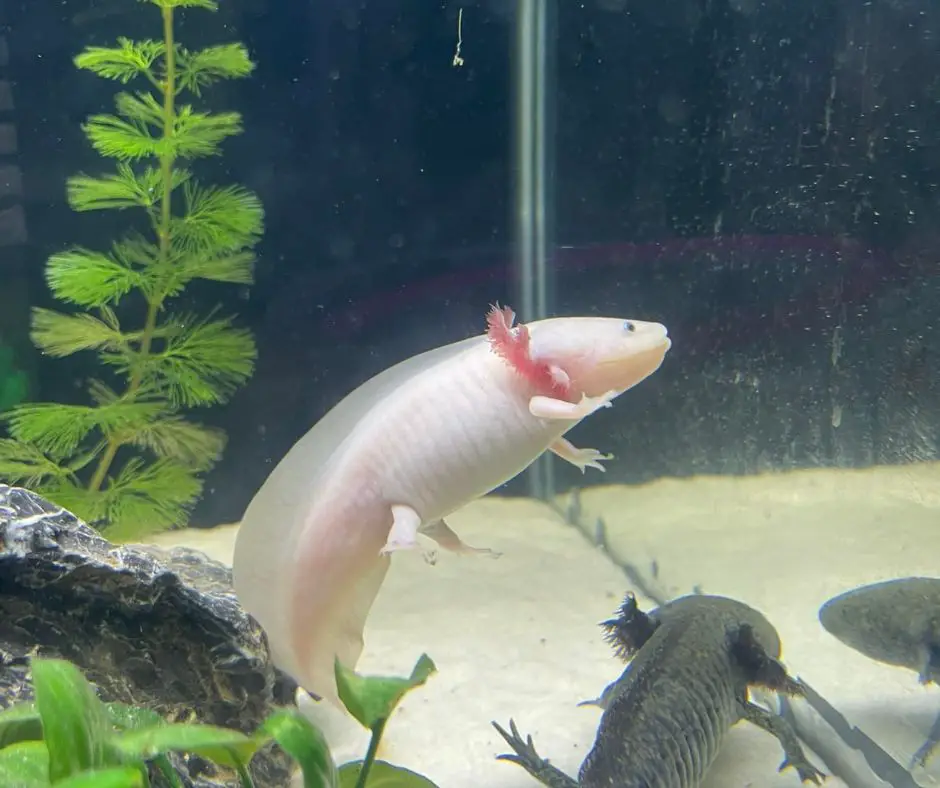
Hornwort, a rootless floating plant, grows up to a foot in height and can serve a great midground or background plant in axolotl tanks. The plant is rootless, so it can be tied down to something.
This plant grows fast in well-lit and warm conditions, but does pretty well in dim and cool conditions.
This capacity for survival in cool temperatures makes hornwort one of the best plants for axolotl tanks.
Hornwort gets tall, but don’t worry about it. The stems are weak and delicate, so your axolotl will not be able to climb them. The plant is very soft, and therefore it won’t injure your axolotl.
It’s safe for your little dragon. If the animal happens to eat the plant, it won’t cause any harm.
Axolotls can eat the food and debris caught in the net-like branches of the plant. It is also great for oxygenation and water filtratio
n. It sucks nitrates and ammonia out of the tank.
5. Duckweed/Frogbit/Water Lettuce
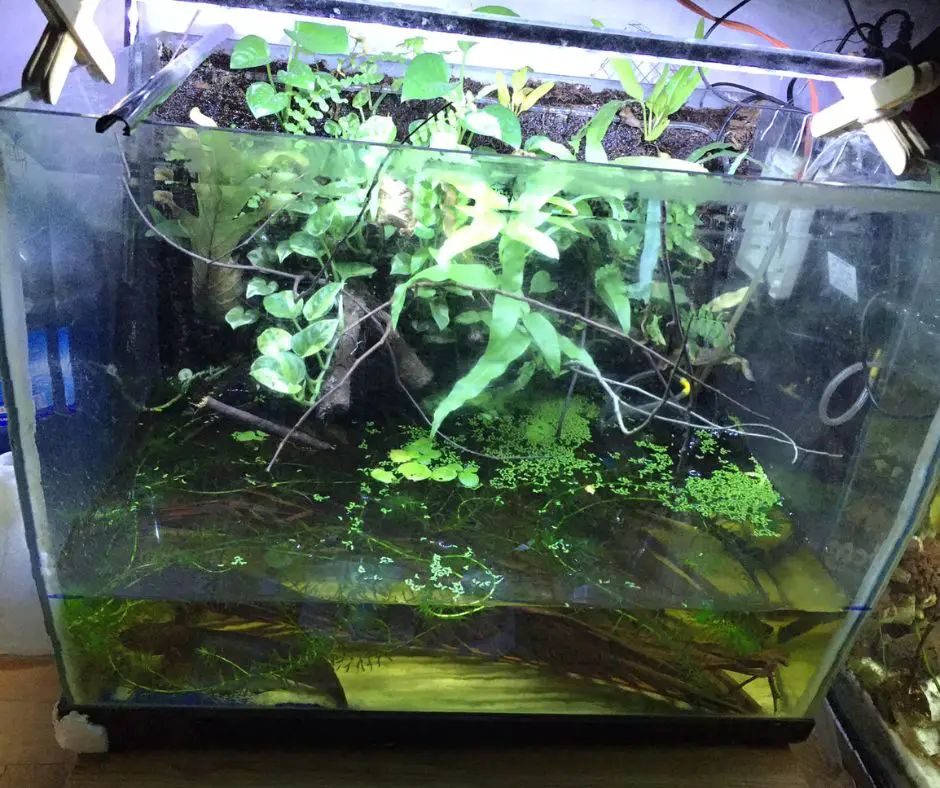
Duckweed is a floating plant suitable for being kept in axolotl tanks. One of the reasons for its popularity is that it is very easy to care for.
While duckweed grows fast when it gets adequate light, it survives in dim places. Its growth just gets slower.
The plant does pretty well in cool waters. Its ideal water temperature is from 28 °C to 32 °C. But it can survive in much lower temperatures. It’s a floating plant, so your axolotl will not be able to uproot it.
Frogbit is another aquarium plant that doesn’t require any substrate. It can survive in cool waters and doesn’t require much light.
The plant can tolerate temperatures ranging from 17° C to 28 84°C. That’s why it’s considered one of the best plants for axolotl tanks.
Water lettuce is another floating plant, considered ideal for axolotl tanks. The ideal range of water temperature for the plant is 21°C to 26°C. pH tolerance range is 6.5 to 7.2. The plant also has a very little demand for light.
6. Marimo
The marimo moss ball not only adds visual appeal to an axolotl tank but also offers some practical benefits. The plant is a bit bizarre, but it’s also beautiful.
As the name suggests, this algae is a moss ball. Marimo is suitable for axolotl tanks mainly for the reason that it thrives in cool water.
It also requires very little light, and that’s another plus. Compared to other aquatic mosses, marimo moss balls need very little care.
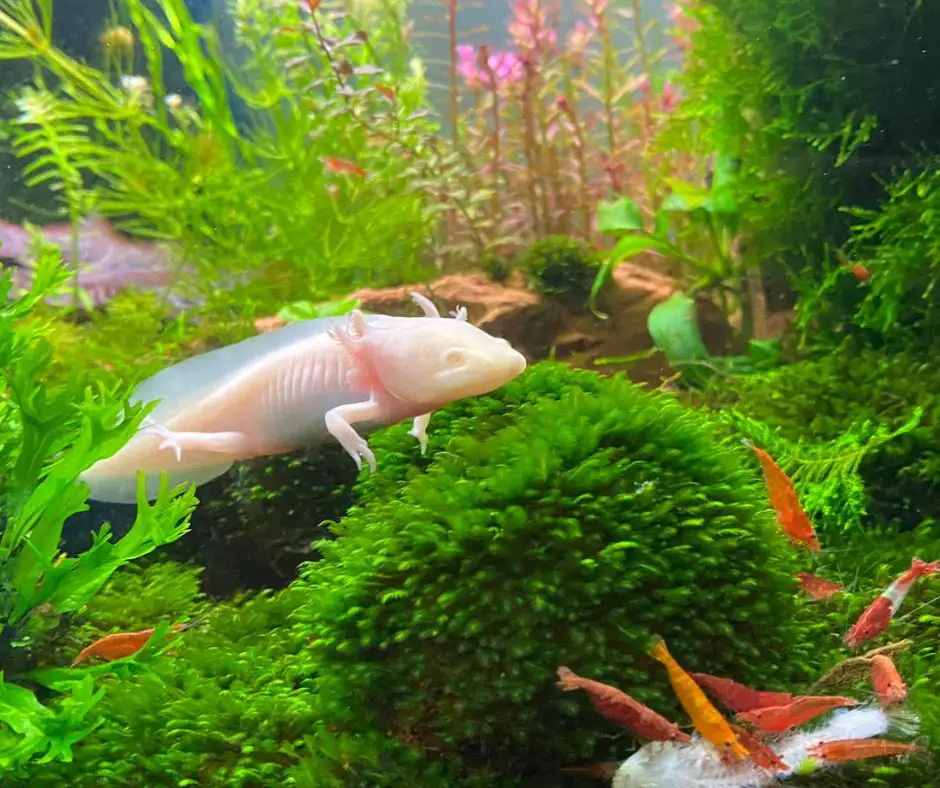
Which Plants Are Best for Axolotl?
For axolotl tanks, the best options are floating plants that do not require much light. The plants you choose should also survive in low temperatures.
They should also be easy to maintain. Let’s dive a little bit.
Floating Plants
Floating plants are easy to care for, and give your aquarium a natural and wild feel. With floating plants, your axolotl tank will become a natural habitat.
These plants have an aesthetic appeal, but they also offer some other benefits.
First, floating plants provide shade. They float on the surface, and that means they limit the amount of light entering the water. And that makes the habitat more comfortable for your axolotl.
They serve as living filters and reduce nitrate levels in the water. They also make great hiding spots for your axolotl.
With that said, there are some disadvantages of aquarium floating plants. If you keep a tank mate for your axolotl, the floating plant may cause some discomfort for the creature.
Most floating plants tend to overgrow, and that can be a nuisance. These plants may also deplete nighttime oxygen levels in the tank water.
However, the depletion is usually insignificant, and it will not affect the well-being of your axolotl or its tank buddy.
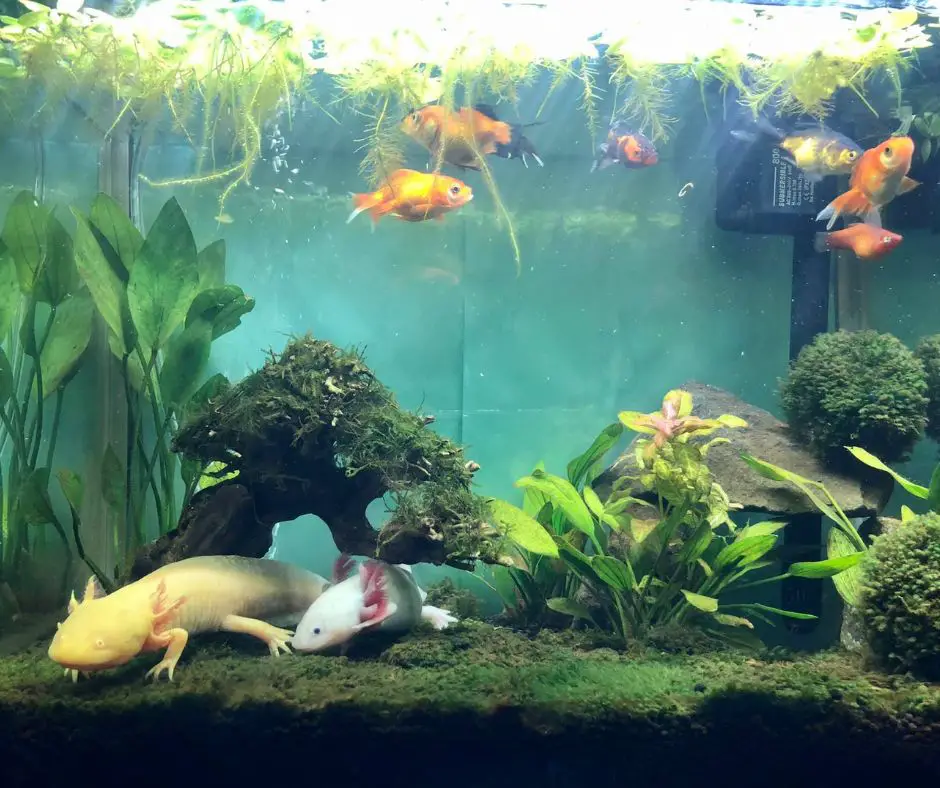
Epiphytes
Epiphytes are widely used for aquascaping, in part because they give a natural impression. Anubias, bucephalandras and ferns are the most common plants that belong to epiphytes.
With their holdfast roots, epiphytes precisely attach to objects in aquariums. So, you do not need to insert these plants into the substrate.
If the plant is placed into gravel, sand or soil, the rhizome or rootstock may rot. During set-up, you can fix epiphytes in your axolotl tank.
The plant can either be wedged between landscape elements or tied onto something.
Epiphytes tend to grow slowly and require little to no lighting and fertilizers. That means they are very easy to care for, and perfect for axolotl tanks.
Popular epiphytes include anubias barteri, microsorum pteropus, and bolbitis heudelotii.
Too many epiphytes in the tank may be detrimental to your axolotl. So, make sure these plants do not overgrow in the tank.
Rooted Plants
Rooted plants need soil to live on. These plants are not usually recommended for aquariums.
But if you want to keep them in your axolotl tank, for whatever reason, it is important to keep a few things in mind.
First, rooted plants need time to settle in. So, once you have picked a spot for the plant, don’t move it around. Unlike rhizome plants, rooted plants may die if you move them.
The substrate depth should be 2 to 3 inches so that the plants have enough room to grow deeper roots and not get uprooted at the slightest touch.
Make sure the substrate particles are not too large or too small. If they are too large, like small river rocks, the roots will not have much surface area to hold on.
And if you use sand as the substrate, there will be hardly any space between the particles. So, the roots won’t grow properly.
Your axolotl will be just fine with rooted plants in the tank. Just be careful about the things mentioned above.
Also read: 20 Best Plants for Axolotl
Live Aquarium Plants
- Staurogyne repens is a fresh green, compact and hardy plant for the foreground of the aquarium and it was found in River Rio Cristalino in the southern Amazonas. Its nearest relative in the aquaristic is Hygrophila but Staurogyne is different with its marked compact, low and bushy stature (5-10 cm) and small green leaves (each stem is 3.4 cm wide)
- Water Temperature:Tropical
- In a rare case of dead on arrival, Buyers must take a clear picture immediately of the plants in unopened bag condition and send the photo to my message the same day of delivery. After I receive the clear photo, I will decide either give you a refund or replacement.
- You will get 1 tissue culture cup of Staurogyne Repens. ( cup size: 2.5'' x 2.5'' ) - 100% Snails, Algae, Bacteria-Free!
- During planting in the aquarium, the longest upright shoots should be cut off and new horizontally creeping shoots will soon form from the plant basis and gradually colonize the gravel.
Last update on 2022-12-29 / Affiliate links / Images from Amazon Product Advertising API
Wrapping Up
Plants can make an axolotl tank resemble a natural habitat. With that said, aquascaping can be tricky because you have to take some factors into consideration.
There are not many plants that are suitable for axolotl tanks, so it’s important to be a bit choosy.
We have discussed the 6 best cold water plants for axolotl tanks, and we hope you have found the post helpful. Feel free to choose any of these 6 options.


